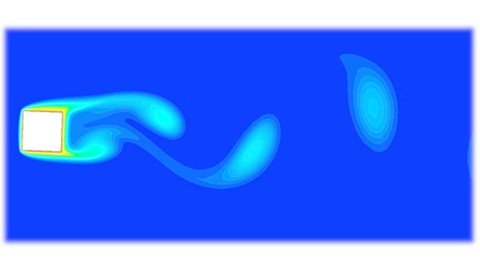
Last updated 6/2022
MP4 | Video: h264, 1280×720 | Audio: AAC, 44.1 KHz
Language: English | Size: 883.83 MB | Duration: 2h 9m
Performing different flow simulations using ANSYS FLUENT using workbench, detailed explanations and results comparisons
What you’ll learn
CFD with ANSYS FLUENT
Design Modeler to create Geometries
ANSYS Meshing Tool
Setting up and solving any problem in FLUENT
Using CFD Post to generate results to be used further.
Requirements
Basic Microsoft Excel knowledge
Basics of Fluid Mechanics
Basic/Little knowledge of CFD
ANSYS 2021 R2 installed in your computer
Previous ANSYS versions can be used
Description
This course is intended for beginners in CFD. The course is ideal for anyone who want to learn how to use CFD using ANSYS FLUENT. First section includes the introductory lectures for Workbench, DesignModeler, and ANSYS Meshing. The next sections include the workshops. Each workshop is explained in detail followed by the geometry creation, meshing, setup and solution. Post processing is performed before concluding the workshop. The conclusion lecture is included for workshops where the results are compared with research articles or theory in different books of Fluid Mechanics.Throughout this course, we would be using ANSYS Workbench with FLUENT Analysis system. For CAD, we will use ANSYS DesignModeler. For Grid Generation, we will use ANSYS Meshing Tool. ANSYS FLUENT would be used to set up and solve the case model. CFD Post would be used for post processing of results. Microsoft Excel is used where required.The workbench files are provided for each workshop in wbpz format. The results generated are also provided in a compressed file for students to redo the workshops on their own and compare the results.ANSYS Components covered areWorkbenchDesignModelerMeshingFLEUNTCFD PostWhat Students will learnHow to create a geometry in DesignModelerHow to create an optimum mesh using Meshing toolSetting up the both steady state and transient problems in FLUENTGenerating presentable results in CFD PostAssignmentsStudents are encouraged to redo the problems solved in the workshops as an assignment.If any problems are faced during assignments, students are most welcome to ask questions.Additional Course detailsThe version used here throughout the course is ANSYS 2021 R2.The videos are kept short and to the point, to save your precious time and let you practice more.The repetitive steps are fast forwarded to focus on the skill development in quickest way possible.The course is about performing CFD using FLUENT. The concepts are explained in detail according to the scope of this course. The options selected during workshops have theoretical background related to CFD and are explained in FLUENT Documentation.The course would be updated regularly with new workshops considering the students feedback.
Overview
Section 1: Introduction
Lecture 1 1.1 Course Preview
Lecture 2 1.2 Course Introduction
Lecture 3 1.3 Introduction to ANSYS Workbench
Lecture 4 1.4 Introduction to ANSYS DesignModeler
Lecture 5 1.5 Introduction to ANSYS Meshing
Section 2: Workshop 1 (Flow Inside a Pipe)
Lecture 6 2.1 Problem Description and Geometry Simplification
Lecture 7 2.2 Geometry Creation
Lecture 8 2.3 Meshing
Lecture 9 2.4 FLUENT Setup
Lecture 10 2.5 Post Processing
Lecture 11 2.6 Geometry and Mesh
Lecture 12 2.7 FLUENT Setup
Lecture 13 2.8 Post Processing
Lecture 14 2.9 Conclusion
Section 3: Workshop 2 (DE LAVAL Nozzle)
Lecture 15 3.1 Problem Description and Geometry Simplification
Lecture 16 3.2 Geometry Creation
Lecture 17 3.3 Meshing
Lecture 18 3.4 FLUENT Setup
Lecture 19 3.5 Post Processing
Lecture 20 3.6 Conclusion
Section 4: Workshop 3 ( Oil Drop Under Gravity)
Lecture 21 4.1 Problem Description and Geometry Simplification
Lecture 22 4.2 Creating Geometry
Lecture 23 4.3 Meshing
Lecture 24 4.4 FLUENT Setup
Lecture 25 4.5 Post Processing
Section 5: Workshop 4 (Flow Distribution)
Lecture 26 5.1 Problem Description and Geometry Simplification
Lecture 27 5.2 Geometry Creation
Lecture 28 5.3 Meshing
Lecture 29 5.4 FLUENT Setup
Lecture 30 5.5 Design Points (Parameter Settings)
Lecture 31 5.6 Post Processing
Lecture 32 5.7 Conclusion
Section 6: Flow Levelling
Lecture 33 6.1 Problem Description and Geometry Simplification
Lecture 34 6.2 Geometry Creation
Lecture 35 6.3 Meshing
Lecture 36 6.4 FLUENT Setup
Lecture 37 6.5 Post Processing
Lecture 38 6.6 Conclusion
Engineering Students,Beginners in CFD,Designers interested in learning ANSYS FLUENT using Workbench,Instructors and researchers
Password/解压密码www.tbtos.com